Finance & Reporting Online Exam Solution: Budgeting, Goodwill, Ratios
VerifiedAdded on 2023/06/15
|16
|3196
|235
Homework Assignment
AI Summary
This document provides a detailed solution to an online exam in Finance and Financial Reporting. It addresses the impact of COVID-19 on organizational finance, covering topics such as budgeting, goodwill calculation (including a numerical example), ratio analysis with interpretations, and methods of raising finance. The solution includes an income statement, corporation tax calculation, and a statement of financial position. Furthermore, it calculates and interprets key financial ratios like gross profit margin, operating profit margin, trade receivable days, and trade payable days. Finally, the document includes a Net Present Value (NPV) calculation for project evaluation. Desklib offers similar solved assignments and study resources for students.
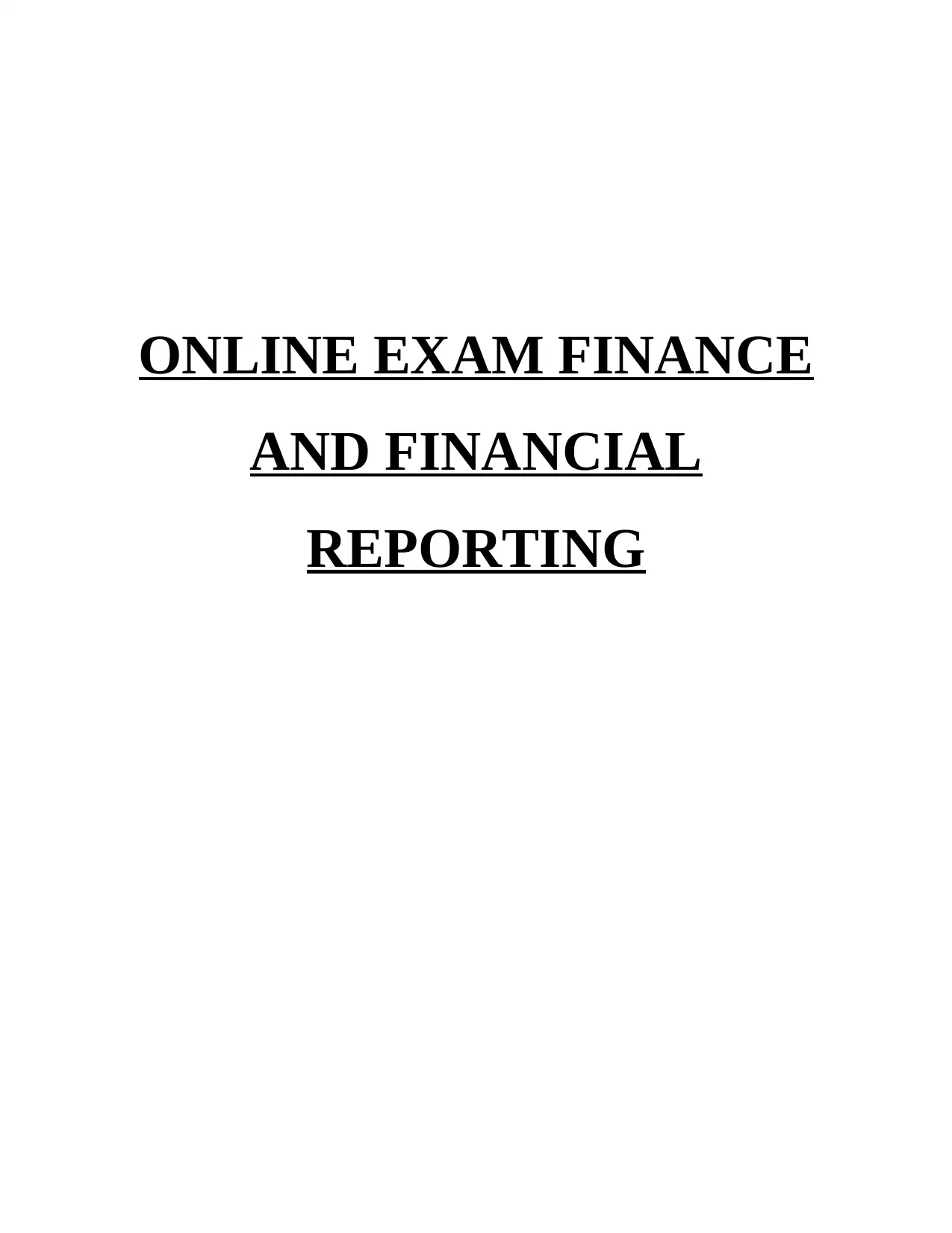
ONLINE EXAM FINANCE
AND FINANCIAL
REPORTING
AND FINANCIAL
REPORTING
Secure Best Marks with AI Grader
Need help grading? Try our AI Grader for instant feedback on your assignments.
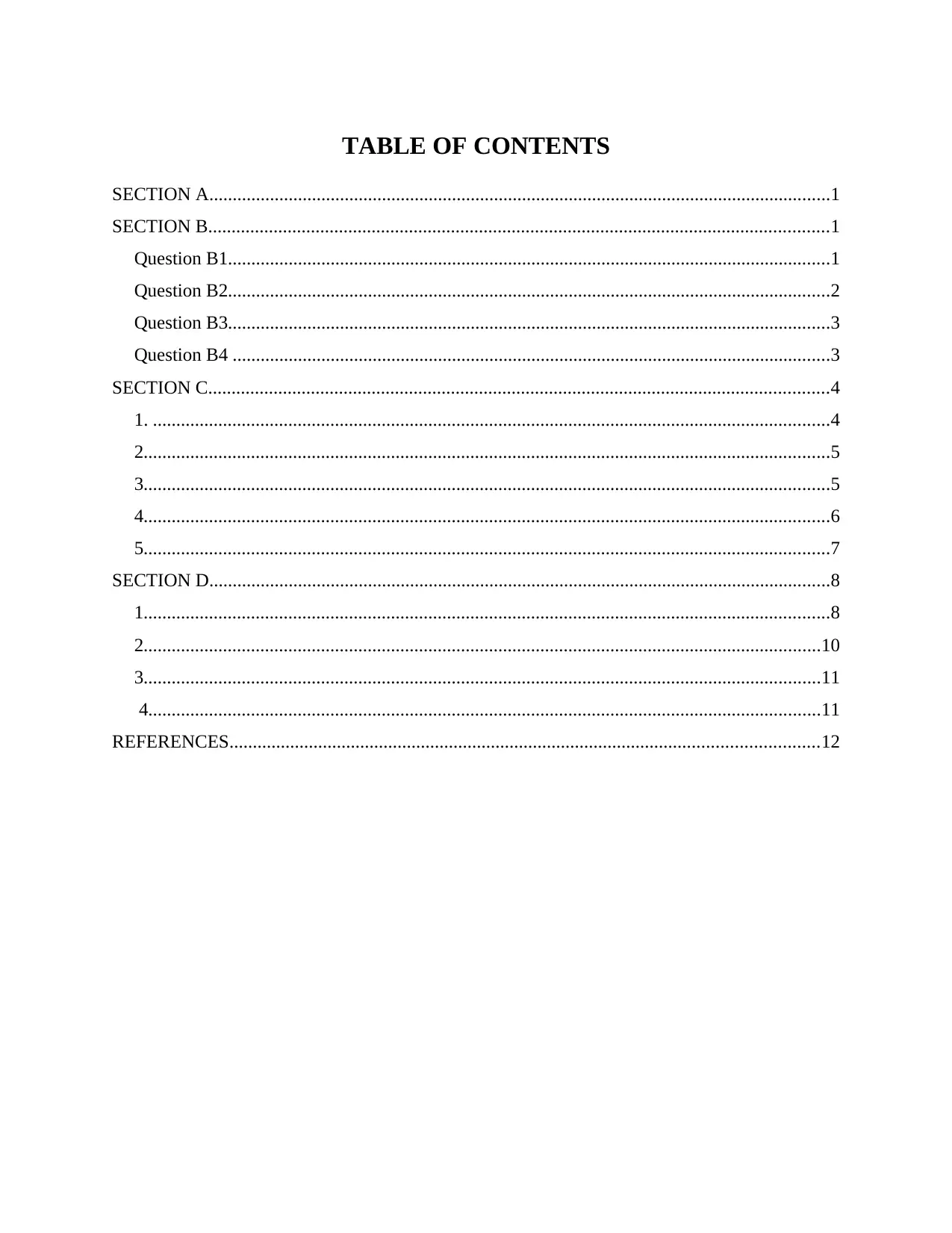
TABLE OF CONTENTS
SECTION A.....................................................................................................................................1
SECTION B.....................................................................................................................................1
Question B1.................................................................................................................................1
Question B2.................................................................................................................................2
Question B3.................................................................................................................................3
Question B4 ................................................................................................................................3
SECTION C.....................................................................................................................................4
1. .................................................................................................................................................4
2...................................................................................................................................................5
3...................................................................................................................................................5
4...................................................................................................................................................6
5...................................................................................................................................................7
SECTION D.....................................................................................................................................8
1...................................................................................................................................................8
2.................................................................................................................................................10
3.................................................................................................................................................11
4................................................................................................................................................11
REFERENCES..............................................................................................................................12
SECTION A.....................................................................................................................................1
SECTION B.....................................................................................................................................1
Question B1.................................................................................................................................1
Question B2.................................................................................................................................2
Question B3.................................................................................................................................3
Question B4 ................................................................................................................................3
SECTION C.....................................................................................................................................4
1. .................................................................................................................................................4
2...................................................................................................................................................5
3...................................................................................................................................................5
4...................................................................................................................................................6
5...................................................................................................................................................7
SECTION D.....................................................................................................................................8
1...................................................................................................................................................8
2.................................................................................................................................................10
3.................................................................................................................................................11
4................................................................................................................................................11
REFERENCES..............................................................................................................................12
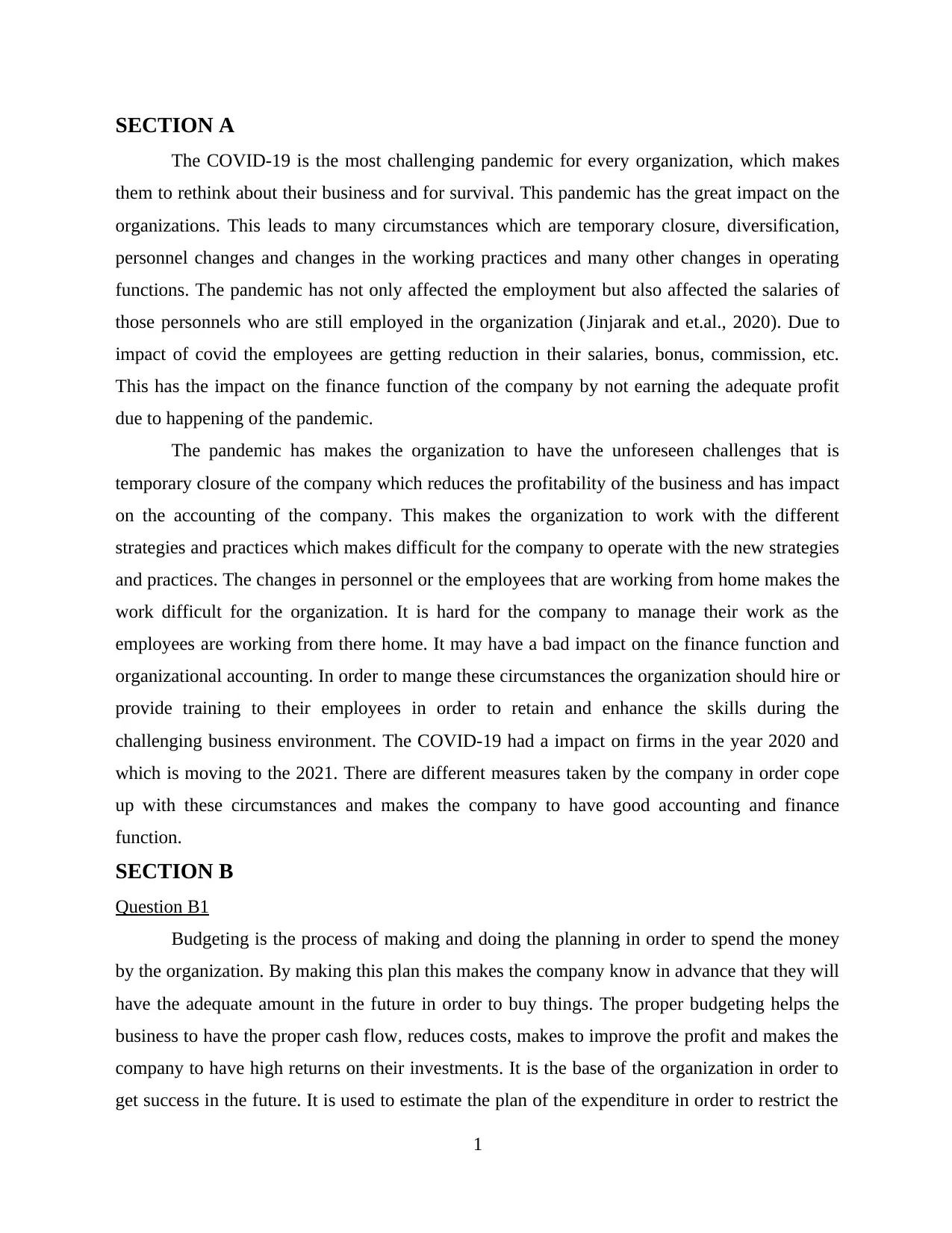
SECTION A
The COVID-19 is the most challenging pandemic for every organization, which makes
them to rethink about their business and for survival. This pandemic has the great impact on the
organizations. This leads to many circumstances which are temporary closure, diversification,
personnel changes and changes in the working practices and many other changes in operating
functions. The pandemic has not only affected the employment but also affected the salaries of
those personnels who are still employed in the organization (Jinjarak and et.al., 2020). Due to
impact of covid the employees are getting reduction in their salaries, bonus, commission, etc.
This has the impact on the finance function of the company by not earning the adequate profit
due to happening of the pandemic.
The pandemic has makes the organization to have the unforeseen challenges that is
temporary closure of the company which reduces the profitability of the business and has impact
on the accounting of the company. This makes the organization to work with the different
strategies and practices which makes difficult for the company to operate with the new strategies
and practices. The changes in personnel or the employees that are working from home makes the
work difficult for the organization. It is hard for the company to manage their work as the
employees are working from there home. It may have a bad impact on the finance function and
organizational accounting. In order to mange these circumstances the organization should hire or
provide training to their employees in order to retain and enhance the skills during the
challenging business environment. The COVID-19 had a impact on firms in the year 2020 and
which is moving to the 2021. There are different measures taken by the company in order cope
up with these circumstances and makes the company to have good accounting and finance
function.
SECTION B
Question B1
Budgeting is the process of making and doing the planning in order to spend the money
by the organization. By making this plan this makes the company know in advance that they will
have the adequate amount in the future in order to buy things. The proper budgeting helps the
business to have the proper cash flow, reduces costs, makes to improve the profit and makes the
company to have high returns on their investments. It is the base of the organization in order to
get success in the future. It is used to estimate the plan of the expenditure in order to restrict the
1
The COVID-19 is the most challenging pandemic for every organization, which makes
them to rethink about their business and for survival. This pandemic has the great impact on the
organizations. This leads to many circumstances which are temporary closure, diversification,
personnel changes and changes in the working practices and many other changes in operating
functions. The pandemic has not only affected the employment but also affected the salaries of
those personnels who are still employed in the organization (Jinjarak and et.al., 2020). Due to
impact of covid the employees are getting reduction in their salaries, bonus, commission, etc.
This has the impact on the finance function of the company by not earning the adequate profit
due to happening of the pandemic.
The pandemic has makes the organization to have the unforeseen challenges that is
temporary closure of the company which reduces the profitability of the business and has impact
on the accounting of the company. This makes the organization to work with the different
strategies and practices which makes difficult for the company to operate with the new strategies
and practices. The changes in personnel or the employees that are working from home makes the
work difficult for the organization. It is hard for the company to manage their work as the
employees are working from there home. It may have a bad impact on the finance function and
organizational accounting. In order to mange these circumstances the organization should hire or
provide training to their employees in order to retain and enhance the skills during the
challenging business environment. The COVID-19 had a impact on firms in the year 2020 and
which is moving to the 2021. There are different measures taken by the company in order cope
up with these circumstances and makes the company to have good accounting and finance
function.
SECTION B
Question B1
Budgeting is the process of making and doing the planning in order to spend the money
by the organization. By making this plan this makes the company know in advance that they will
have the adequate amount in the future in order to buy things. The proper budgeting helps the
business to have the proper cash flow, reduces costs, makes to improve the profit and makes the
company to have high returns on their investments. It is the base of the organization in order to
get success in the future. It is used to estimate the plan of the expenditure in order to restrict the
1
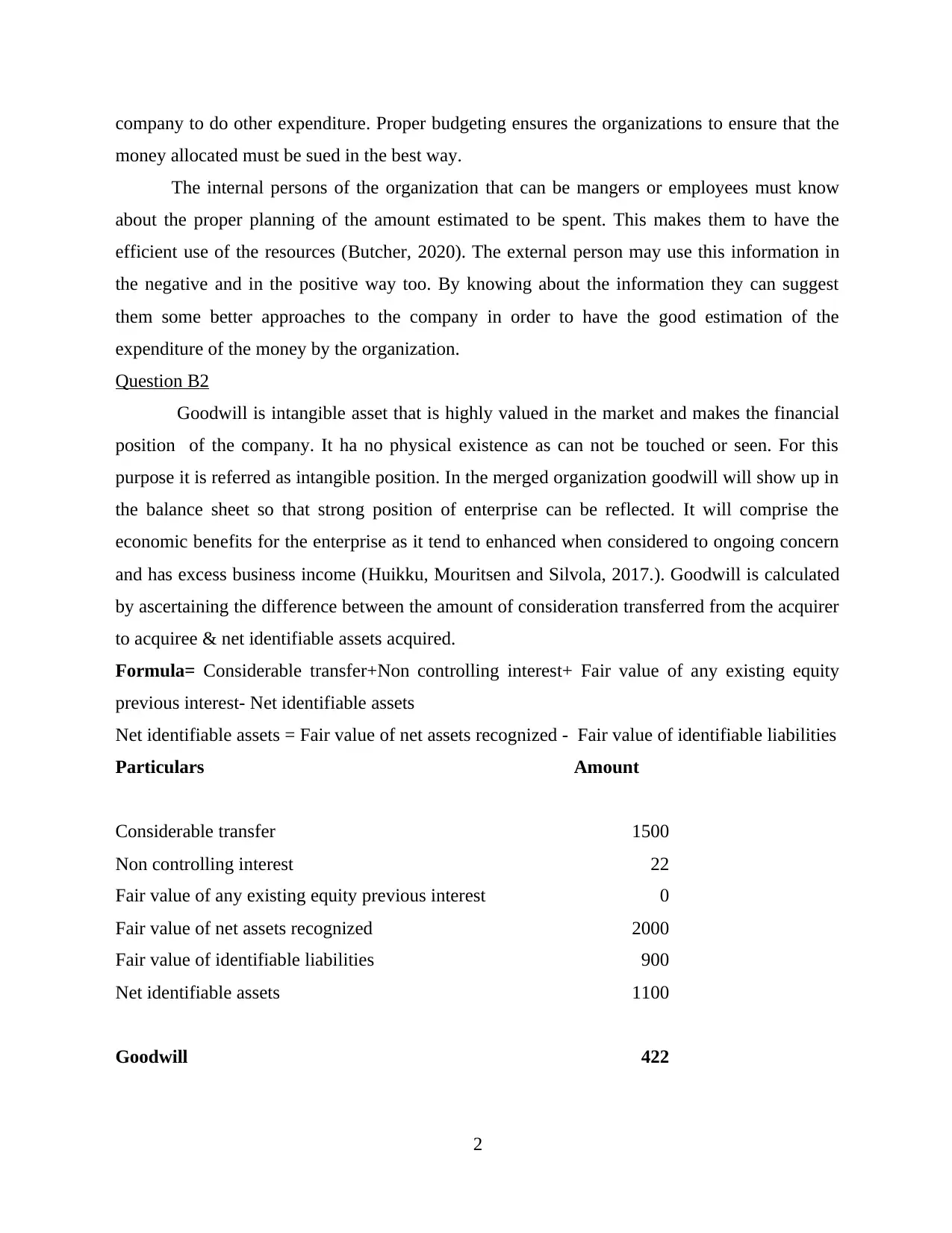
company to do other expenditure. Proper budgeting ensures the organizations to ensure that the
money allocated must be sued in the best way.
The internal persons of the organization that can be mangers or employees must know
about the proper planning of the amount estimated to be spent. This makes them to have the
efficient use of the resources (Butcher, 2020). The external person may use this information in
the negative and in the positive way too. By knowing about the information they can suggest
them some better approaches to the company in order to have the good estimation of the
expenditure of the money by the organization.
Question B2
Goodwill is intangible asset that is highly valued in the market and makes the financial
position of the company. It ha no physical existence as can not be touched or seen. For this
purpose it is referred as intangible position. In the merged organization goodwill will show up in
the balance sheet so that strong position of enterprise can be reflected. It will comprise the
economic benefits for the enterprise as it tend to enhanced when considered to ongoing concern
and has excess business income (Huikku, Mouritsen and Silvola, 2017.). Goodwill is calculated
by ascertaining the difference between the amount of consideration transferred from the acquirer
to acquiree & net identifiable assets acquired.
Formula= Considerable transfer+Non controlling interest+ Fair value of any existing equity
previous interest- Net identifiable assets
Net identifiable assets = Fair value of net assets recognized - Fair value of identifiable liabilities
Particulars Amount
Considerable transfer 1500
Non controlling interest 22
Fair value of any existing equity previous interest 0
Fair value of net assets recognized 2000
Fair value of identifiable liabilities 900
Net identifiable assets 1100
Goodwill 422
2
money allocated must be sued in the best way.
The internal persons of the organization that can be mangers or employees must know
about the proper planning of the amount estimated to be spent. This makes them to have the
efficient use of the resources (Butcher, 2020). The external person may use this information in
the negative and in the positive way too. By knowing about the information they can suggest
them some better approaches to the company in order to have the good estimation of the
expenditure of the money by the organization.
Question B2
Goodwill is intangible asset that is highly valued in the market and makes the financial
position of the company. It ha no physical existence as can not be touched or seen. For this
purpose it is referred as intangible position. In the merged organization goodwill will show up in
the balance sheet so that strong position of enterprise can be reflected. It will comprise the
economic benefits for the enterprise as it tend to enhanced when considered to ongoing concern
and has excess business income (Huikku, Mouritsen and Silvola, 2017.). Goodwill is calculated
by ascertaining the difference between the amount of consideration transferred from the acquirer
to acquiree & net identifiable assets acquired.
Formula= Considerable transfer+Non controlling interest+ Fair value of any existing equity
previous interest- Net identifiable assets
Net identifiable assets = Fair value of net assets recognized - Fair value of identifiable liabilities
Particulars Amount
Considerable transfer 1500
Non controlling interest 22
Fair value of any existing equity previous interest 0
Fair value of net assets recognized 2000
Fair value of identifiable liabilities 900
Net identifiable assets 1100
Goodwill 422
2
Secure Best Marks with AI Grader
Need help grading? Try our AI Grader for instant feedback on your assignments.
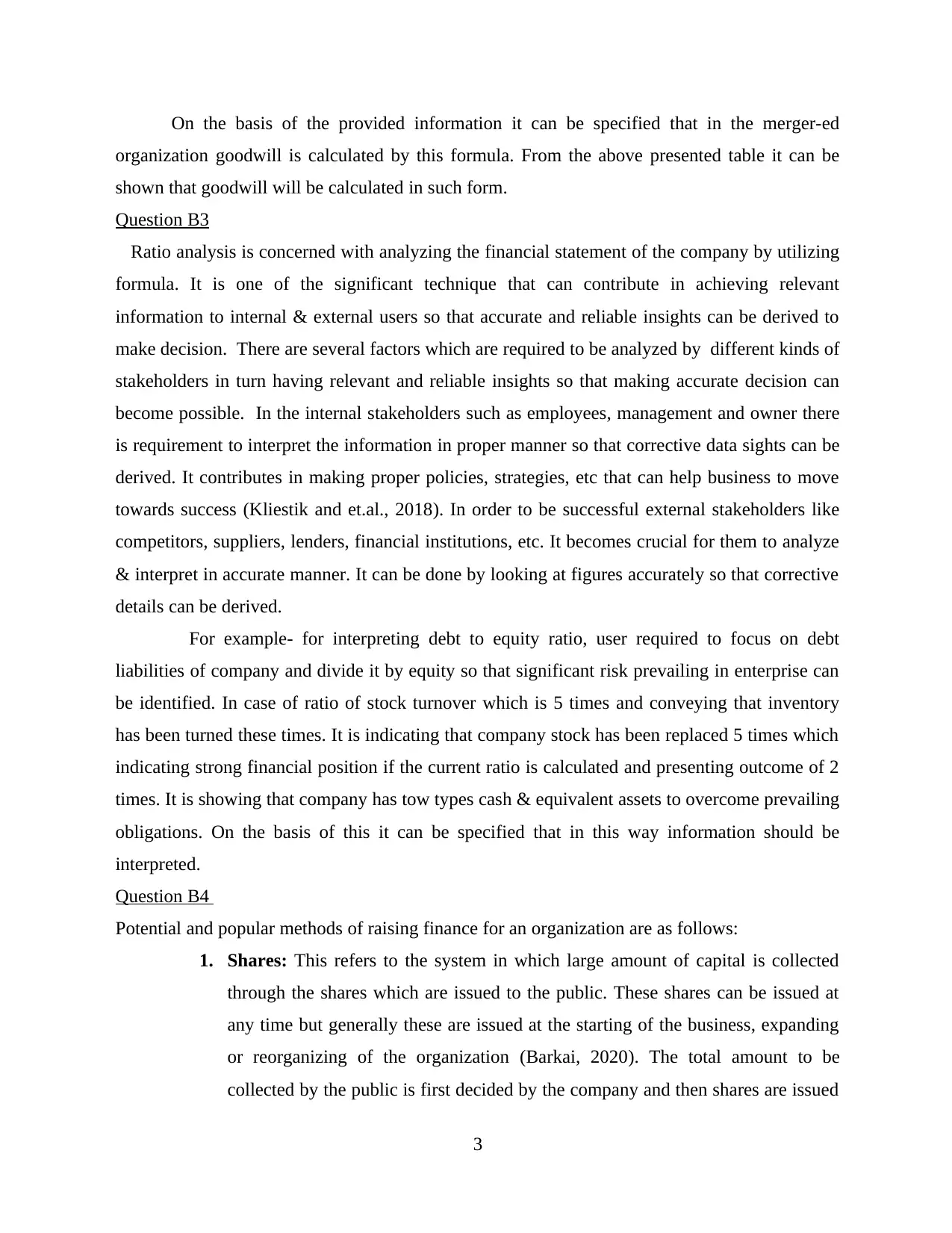
On the basis of the provided information it can be specified that in the merger-ed
organization goodwill is calculated by this formula. From the above presented table it can be
shown that goodwill will be calculated in such form.
Question B3
Ratio analysis is concerned with analyzing the financial statement of the company by utilizing
formula. It is one of the significant technique that can contribute in achieving relevant
information to internal & external users so that accurate and reliable insights can be derived to
make decision. There are several factors which are required to be analyzed by different kinds of
stakeholders in turn having relevant and reliable insights so that making accurate decision can
become possible. In the internal stakeholders such as employees, management and owner there
is requirement to interpret the information in proper manner so that corrective data sights can be
derived. It contributes in making proper policies, strategies, etc that can help business to move
towards success (Kliestik and et.al., 2018). In order to be successful external stakeholders like
competitors, suppliers, lenders, financial institutions, etc. It becomes crucial for them to analyze
& interpret in accurate manner. It can be done by looking at figures accurately so that corrective
details can be derived.
For example- for interpreting debt to equity ratio, user required to focus on debt
liabilities of company and divide it by equity so that significant risk prevailing in enterprise can
be identified. In case of ratio of stock turnover which is 5 times and conveying that inventory
has been turned these times. It is indicating that company stock has been replaced 5 times which
indicating strong financial position if the current ratio is calculated and presenting outcome of 2
times. It is showing that company has tow types cash & equivalent assets to overcome prevailing
obligations. On the basis of this it can be specified that in this way information should be
interpreted.
Question B4
Potential and popular methods of raising finance for an organization are as follows:
1. Shares: This refers to the system in which large amount of capital is collected
through the shares which are issued to the public. These shares can be issued at
any time but generally these are issued at the starting of the business, expanding
or reorganizing of the organization (Barkai, 2020). The total amount to be
collected by the public is first decided by the company and then shares are issued
3
organization goodwill is calculated by this formula. From the above presented table it can be
shown that goodwill will be calculated in such form.
Question B3
Ratio analysis is concerned with analyzing the financial statement of the company by utilizing
formula. It is one of the significant technique that can contribute in achieving relevant
information to internal & external users so that accurate and reliable insights can be derived to
make decision. There are several factors which are required to be analyzed by different kinds of
stakeholders in turn having relevant and reliable insights so that making accurate decision can
become possible. In the internal stakeholders such as employees, management and owner there
is requirement to interpret the information in proper manner so that corrective data sights can be
derived. It contributes in making proper policies, strategies, etc that can help business to move
towards success (Kliestik and et.al., 2018). In order to be successful external stakeholders like
competitors, suppliers, lenders, financial institutions, etc. It becomes crucial for them to analyze
& interpret in accurate manner. It can be done by looking at figures accurately so that corrective
details can be derived.
For example- for interpreting debt to equity ratio, user required to focus on debt
liabilities of company and divide it by equity so that significant risk prevailing in enterprise can
be identified. In case of ratio of stock turnover which is 5 times and conveying that inventory
has been turned these times. It is indicating that company stock has been replaced 5 times which
indicating strong financial position if the current ratio is calculated and presenting outcome of 2
times. It is showing that company has tow types cash & equivalent assets to overcome prevailing
obligations. On the basis of this it can be specified that in this way information should be
interpreted.
Question B4
Potential and popular methods of raising finance for an organization are as follows:
1. Shares: This refers to the system in which large amount of capital is collected
through the shares which are issued to the public. These shares can be issued at
any time but generally these are issued at the starting of the business, expanding
or reorganizing of the organization (Barkai, 2020). The total amount to be
collected by the public is first decided by the company and then shares are issued
3
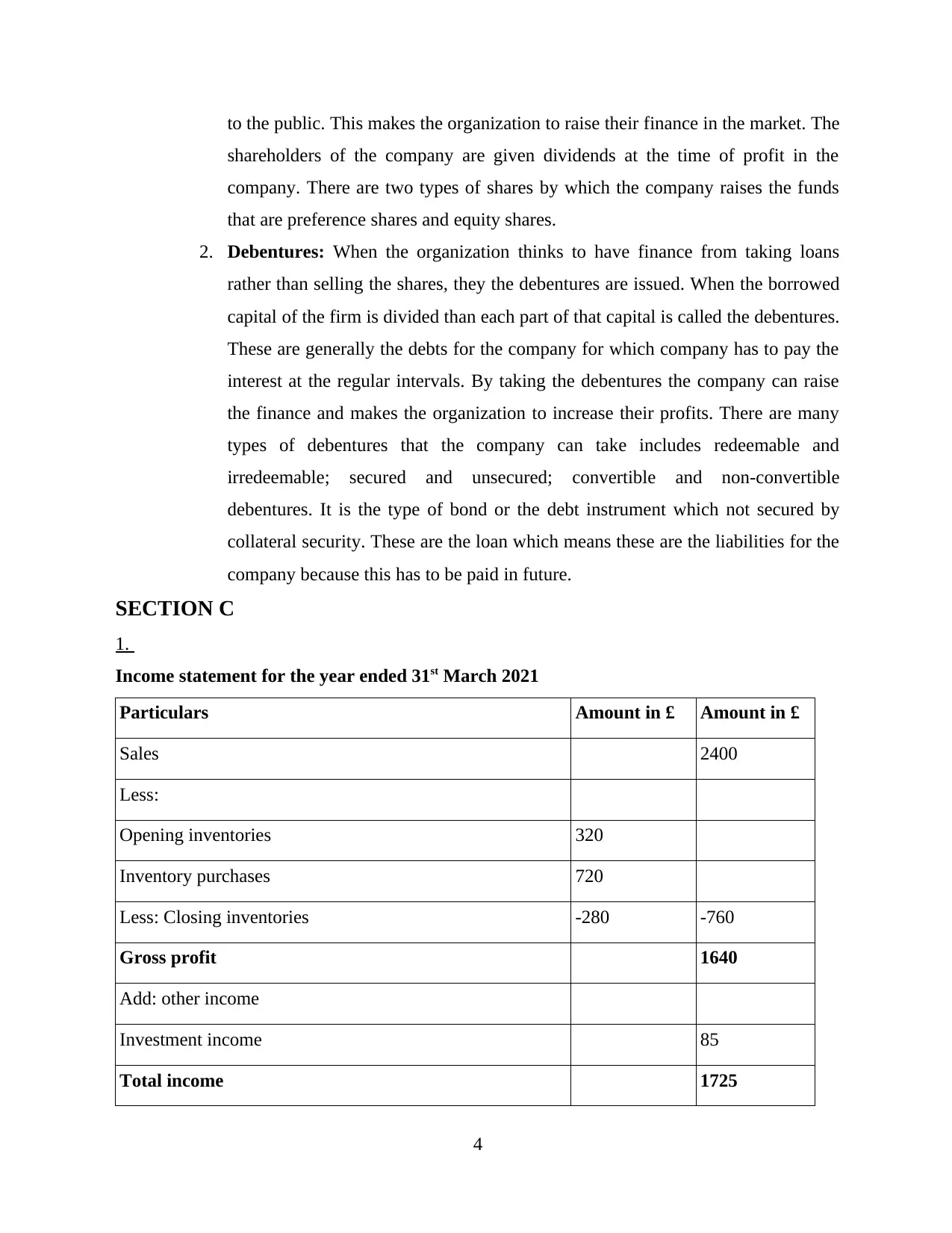
to the public. This makes the organization to raise their finance in the market. The
shareholders of the company are given dividends at the time of profit in the
company. There are two types of shares by which the company raises the funds
that are preference shares and equity shares.
2. Debentures: When the organization thinks to have finance from taking loans
rather than selling the shares, they the debentures are issued. When the borrowed
capital of the firm is divided than each part of that capital is called the debentures.
These are generally the debts for the company for which company has to pay the
interest at the regular intervals. By taking the debentures the company can raise
the finance and makes the organization to increase their profits. There are many
types of debentures that the company can take includes redeemable and
irredeemable; secured and unsecured; convertible and non-convertible
debentures. It is the type of bond or the debt instrument which not secured by
collateral security. These are the loan which means these are the liabilities for the
company because this has to be paid in future.
SECTION C
1.
Income statement for the year ended 31st March 2021
Particulars Amount in £ Amount in £
Sales 2400
Less:
Opening inventories 320
Inventory purchases 720
Less: Closing inventories -280 -760
Gross profit 1640
Add: other income
Investment income 85
Total income 1725
4
shareholders of the company are given dividends at the time of profit in the
company. There are two types of shares by which the company raises the funds
that are preference shares and equity shares.
2. Debentures: When the organization thinks to have finance from taking loans
rather than selling the shares, they the debentures are issued. When the borrowed
capital of the firm is divided than each part of that capital is called the debentures.
These are generally the debts for the company for which company has to pay the
interest at the regular intervals. By taking the debentures the company can raise
the finance and makes the organization to increase their profits. There are many
types of debentures that the company can take includes redeemable and
irredeemable; secured and unsecured; convertible and non-convertible
debentures. It is the type of bond or the debt instrument which not secured by
collateral security. These are the loan which means these are the liabilities for the
company because this has to be paid in future.
SECTION C
1.
Income statement for the year ended 31st March 2021
Particulars Amount in £ Amount in £
Sales 2400
Less:
Opening inventories 320
Inventory purchases 720
Less: Closing inventories -280 -760
Gross profit 1640
Add: other income
Investment income 85
Total income 1725
4
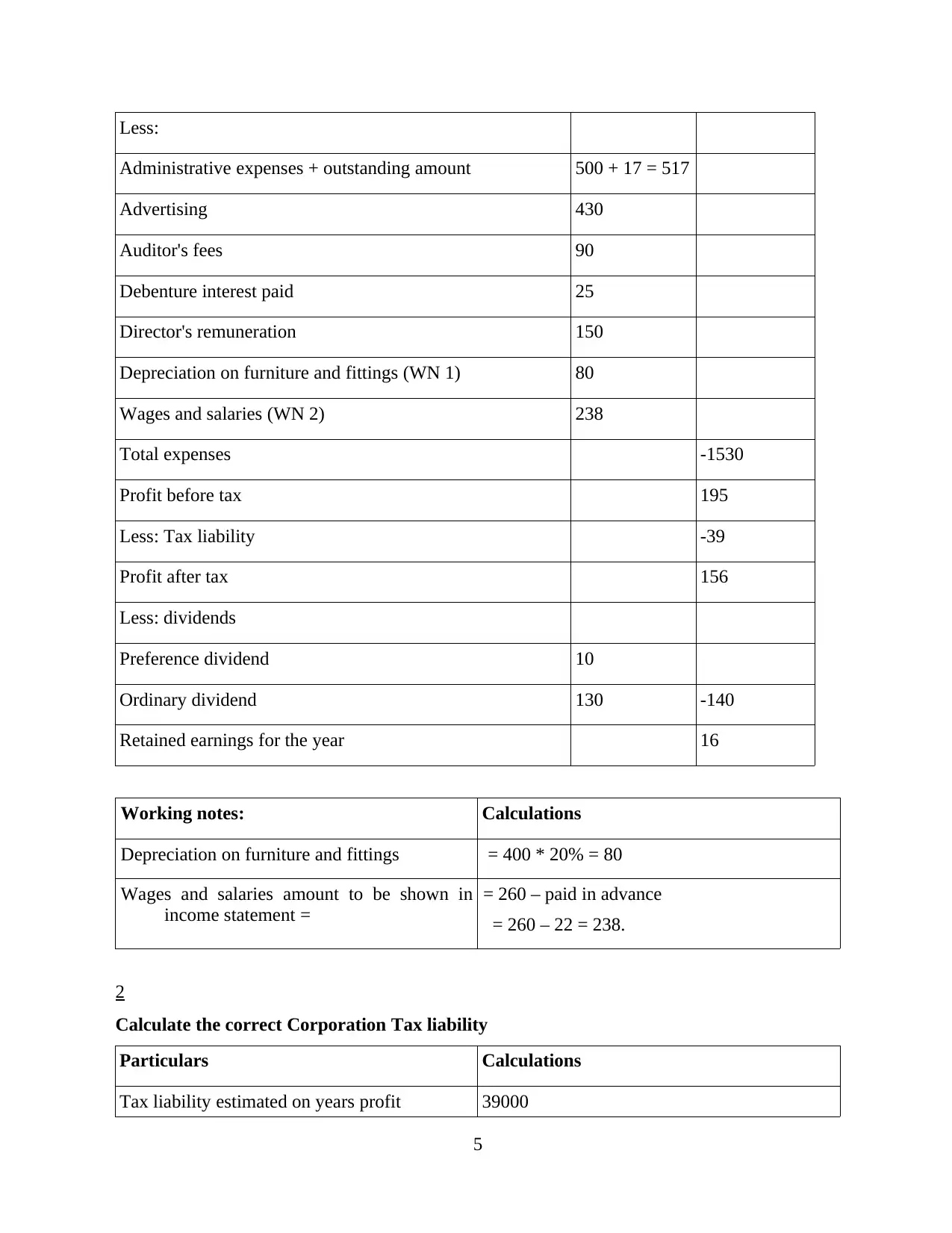
Less:
Administrative expenses + outstanding amount 500 + 17 = 517
Advertising 430
Auditor's fees 90
Debenture interest paid 25
Director's remuneration 150
Depreciation on furniture and fittings (WN 1) 80
Wages and salaries (WN 2) 238
Total expenses -1530
Profit before tax 195
Less: Tax liability -39
Profit after tax 156
Less: dividends
Preference dividend 10
Ordinary dividend 130 -140
Retained earnings for the year 16
Working notes: Calculations
Depreciation on furniture and fittings = 400 * 20% = 80
Wages and salaries amount to be shown in
income statement =
= 260 – paid in advance
= 260 – 22 = 238.
2
Calculate the correct Corporation Tax liability
Particulars Calculations
Tax liability estimated on years profit 39000
5
Administrative expenses + outstanding amount 500 + 17 = 517
Advertising 430
Auditor's fees 90
Debenture interest paid 25
Director's remuneration 150
Depreciation on furniture and fittings (WN 1) 80
Wages and salaries (WN 2) 238
Total expenses -1530
Profit before tax 195
Less: Tax liability -39
Profit after tax 156
Less: dividends
Preference dividend 10
Ordinary dividend 130 -140
Retained earnings for the year 16
Working notes: Calculations
Depreciation on furniture and fittings = 400 * 20% = 80
Wages and salaries amount to be shown in
income statement =
= 260 – paid in advance
= 260 – 22 = 238.
2
Calculate the correct Corporation Tax liability
Particulars Calculations
Tax liability estimated on years profit 39000
5
Paraphrase This Document
Need a fresh take? Get an instant paraphrase of this document with our AI Paraphraser
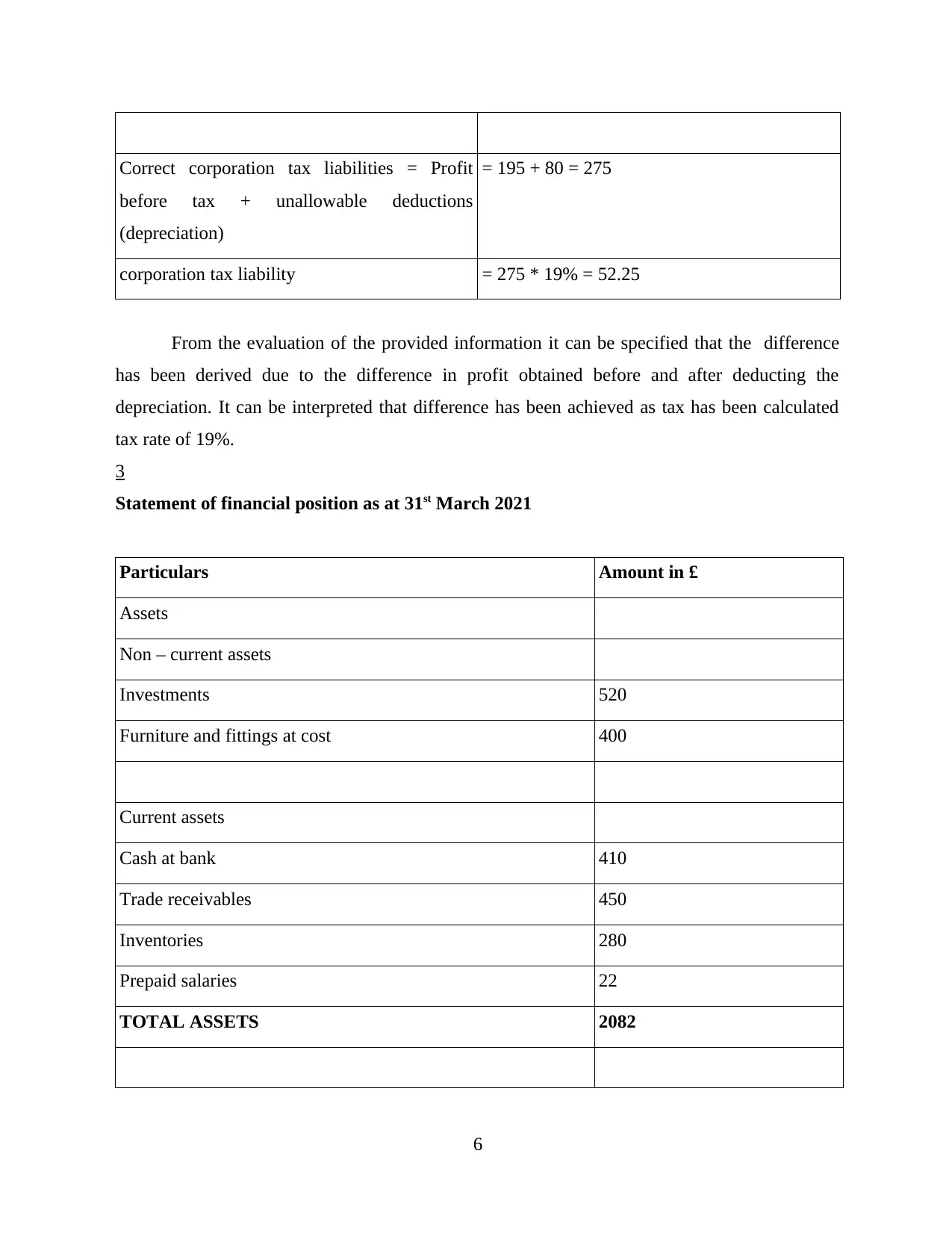
Correct corporation tax liabilities = Profit
before tax + unallowable deductions
(depreciation)
= 195 + 80 = 275
corporation tax liability = 275 * 19% = 52.25
From the evaluation of the provided information it can be specified that the difference
has been derived due to the difference in profit obtained before and after deducting the
depreciation. It can be interpreted that difference has been achieved as tax has been calculated
tax rate of 19%.
3
Statement of financial position as at 31st March 2021
Particulars Amount in £
Assets
Non – current assets
Investments 520
Furniture and fittings at cost 400
Current assets
Cash at bank 410
Trade receivables 450
Inventories 280
Prepaid salaries 22
TOTAL ASSETS 2082
6
before tax + unallowable deductions
(depreciation)
= 195 + 80 = 275
corporation tax liability = 275 * 19% = 52.25
From the evaluation of the provided information it can be specified that the difference
has been derived due to the difference in profit obtained before and after deducting the
depreciation. It can be interpreted that difference has been achieved as tax has been calculated
tax rate of 19%.
3
Statement of financial position as at 31st March 2021
Particulars Amount in £
Assets
Non – current assets
Investments 520
Furniture and fittings at cost 400
Current assets
Cash at bank 410
Trade receivables 450
Inventories 280
Prepaid salaries 22
TOTAL ASSETS 2082
6
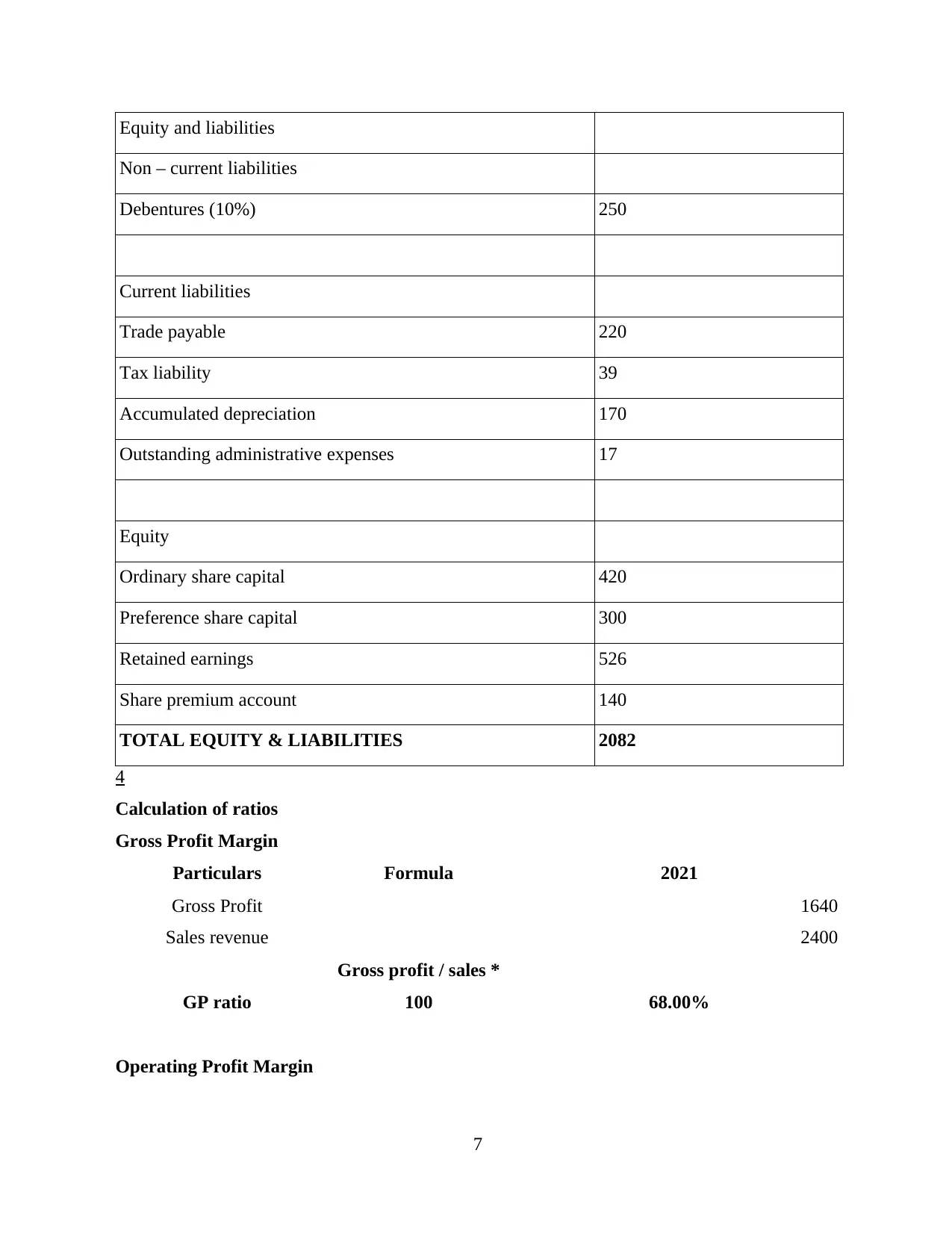
Equity and liabilities
Non – current liabilities
Debentures (10%) 250
Current liabilities
Trade payable 220
Tax liability 39
Accumulated depreciation 170
Outstanding administrative expenses 17
Equity
Ordinary share capital 420
Preference share capital 300
Retained earnings 526
Share premium account 140
TOTAL EQUITY & LIABILITIES 2082
4
Calculation of ratios
Gross Profit Margin
Particulars Formula 2021
Gross Profit 1640
Sales revenue 2400
GP ratio
Gross profit / sales *
100 68.00%
Operating Profit Margin
7
Non – current liabilities
Debentures (10%) 250
Current liabilities
Trade payable 220
Tax liability 39
Accumulated depreciation 170
Outstanding administrative expenses 17
Equity
Ordinary share capital 420
Preference share capital 300
Retained earnings 526
Share premium account 140
TOTAL EQUITY & LIABILITIES 2082
4
Calculation of ratios
Gross Profit Margin
Particulars Formula 2021
Gross Profit 1640
Sales revenue 2400
GP ratio
Gross profit / sales *
100 68.00%
Operating Profit Margin
7
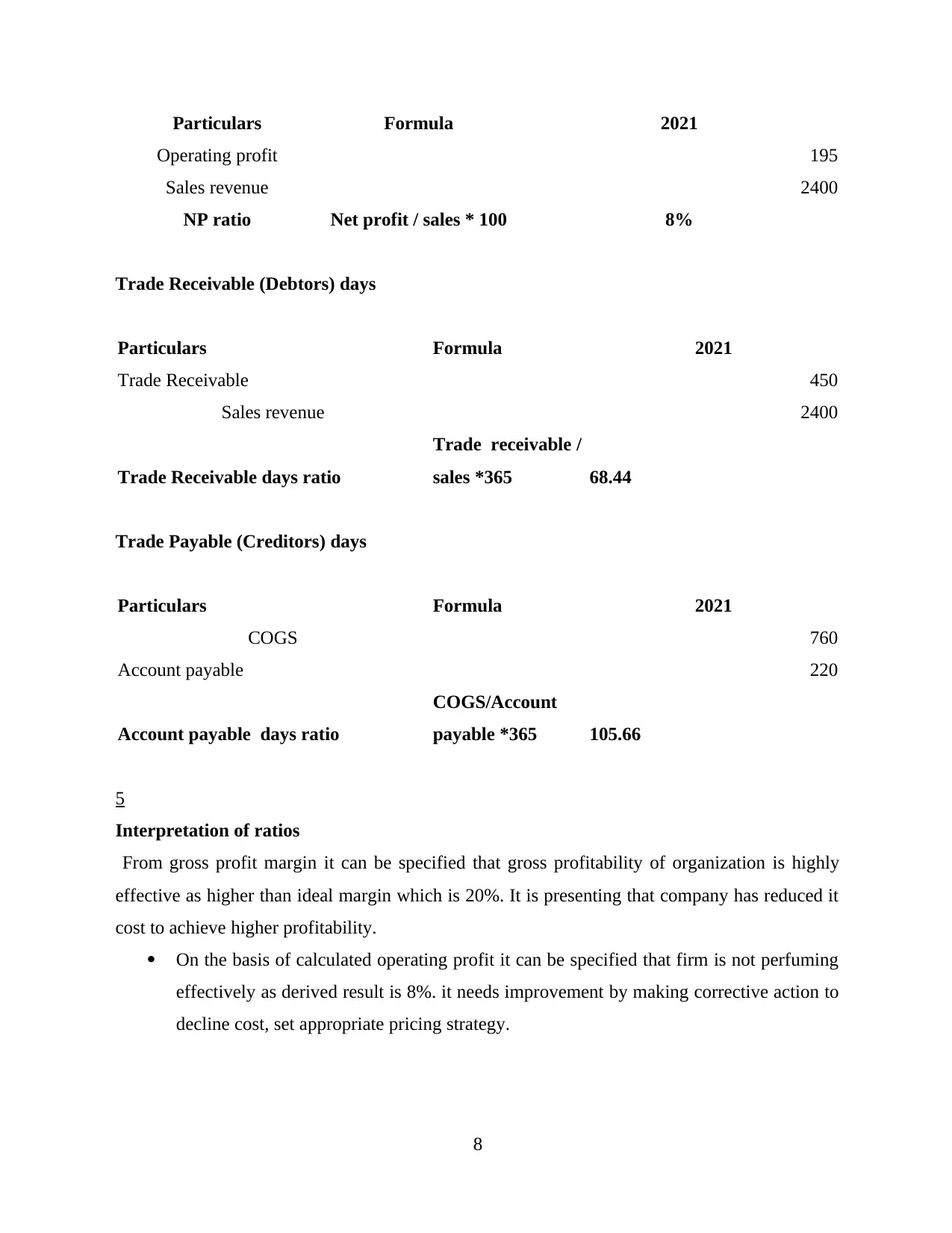
Particulars Formula 2021
Operating profit 195
Sales revenue 2400
NP ratio Net profit / sales * 100 8%
Trade Receivable (Debtors) days
Particulars Formula 2021
Trade Receivable 450
Sales revenue 2400
Trade Receivable days ratio
Trade receivable /
sales *365 68.44
Trade Payable (Creditors) days
Particulars Formula 2021
COGS 760
Account payable 220
Account payable days ratio
COGS/Account
payable *365 105.66
5
Interpretation of ratios
From gross profit margin it can be specified that gross profitability of organization is highly
effective as higher than ideal margin which is 20%. It is presenting that company has reduced it
cost to achieve higher profitability.
On the basis of calculated operating profit it can be specified that firm is not perfuming
effectively as derived result is 8%. it needs improvement by making corrective action to
decline cost, set appropriate pricing strategy.
8
Operating profit 195
Sales revenue 2400
NP ratio Net profit / sales * 100 8%
Trade Receivable (Debtors) days
Particulars Formula 2021
Trade Receivable 450
Sales revenue 2400
Trade Receivable days ratio
Trade receivable /
sales *365 68.44
Trade Payable (Creditors) days
Particulars Formula 2021
COGS 760
Account payable 220
Account payable days ratio
COGS/Account
payable *365 105.66
5
Interpretation of ratios
From gross profit margin it can be specified that gross profitability of organization is highly
effective as higher than ideal margin which is 20%. It is presenting that company has reduced it
cost to achieve higher profitability.
On the basis of calculated operating profit it can be specified that firm is not perfuming
effectively as derived result is 8%. it needs improvement by making corrective action to
decline cost, set appropriate pricing strategy.
8
Secure Best Marks with AI Grader
Need help grading? Try our AI Grader for instant feedback on your assignments.
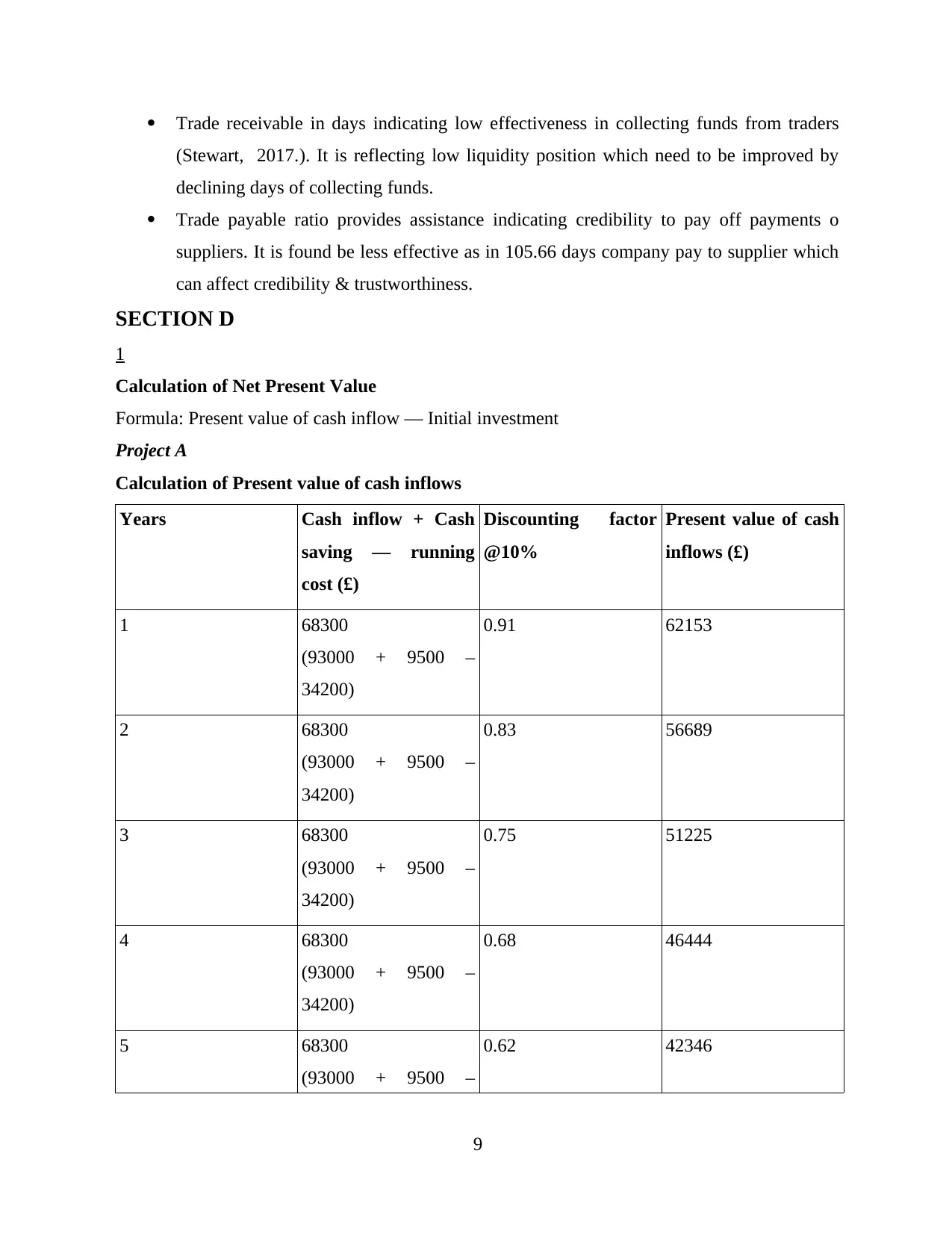
Trade receivable in days indicating low effectiveness in collecting funds from traders
(Stewart, 2017.). It is reflecting low liquidity position which need to be improved by
declining days of collecting funds.
Trade payable ratio provides assistance indicating credibility to pay off payments o
suppliers. It is found be less effective as in 105.66 days company pay to supplier which
can affect credibility & trustworthiness.
SECTION D
1
Calculation of Net Present Value
Formula: Present value of cash inflow — Initial investment
Project A
Calculation of Present value of cash inflows
Years Cash inflow + Cash
saving — running
cost (£)
Discounting factor
@10%
Present value of cash
inflows (£)
1 68300
(93000 + 9500 –
34200)
0.91 62153
2 68300
(93000 + 9500 –
34200)
0.83 56689
3 68300
(93000 + 9500 –
34200)
0.75 51225
4 68300
(93000 + 9500 –
34200)
0.68 46444
5 68300
(93000 + 9500 –
0.62 42346
9
(Stewart, 2017.). It is reflecting low liquidity position which need to be improved by
declining days of collecting funds.
Trade payable ratio provides assistance indicating credibility to pay off payments o
suppliers. It is found be less effective as in 105.66 days company pay to supplier which
can affect credibility & trustworthiness.
SECTION D
1
Calculation of Net Present Value
Formula: Present value of cash inflow — Initial investment
Project A
Calculation of Present value of cash inflows
Years Cash inflow + Cash
saving — running
cost (£)
Discounting factor
@10%
Present value of cash
inflows (£)
1 68300
(93000 + 9500 –
34200)
0.91 62153
2 68300
(93000 + 9500 –
34200)
0.83 56689
3 68300
(93000 + 9500 –
34200)
0.75 51225
4 68300
(93000 + 9500 –
34200)
0.68 46444
5 68300
(93000 + 9500 –
0.62 42346
9
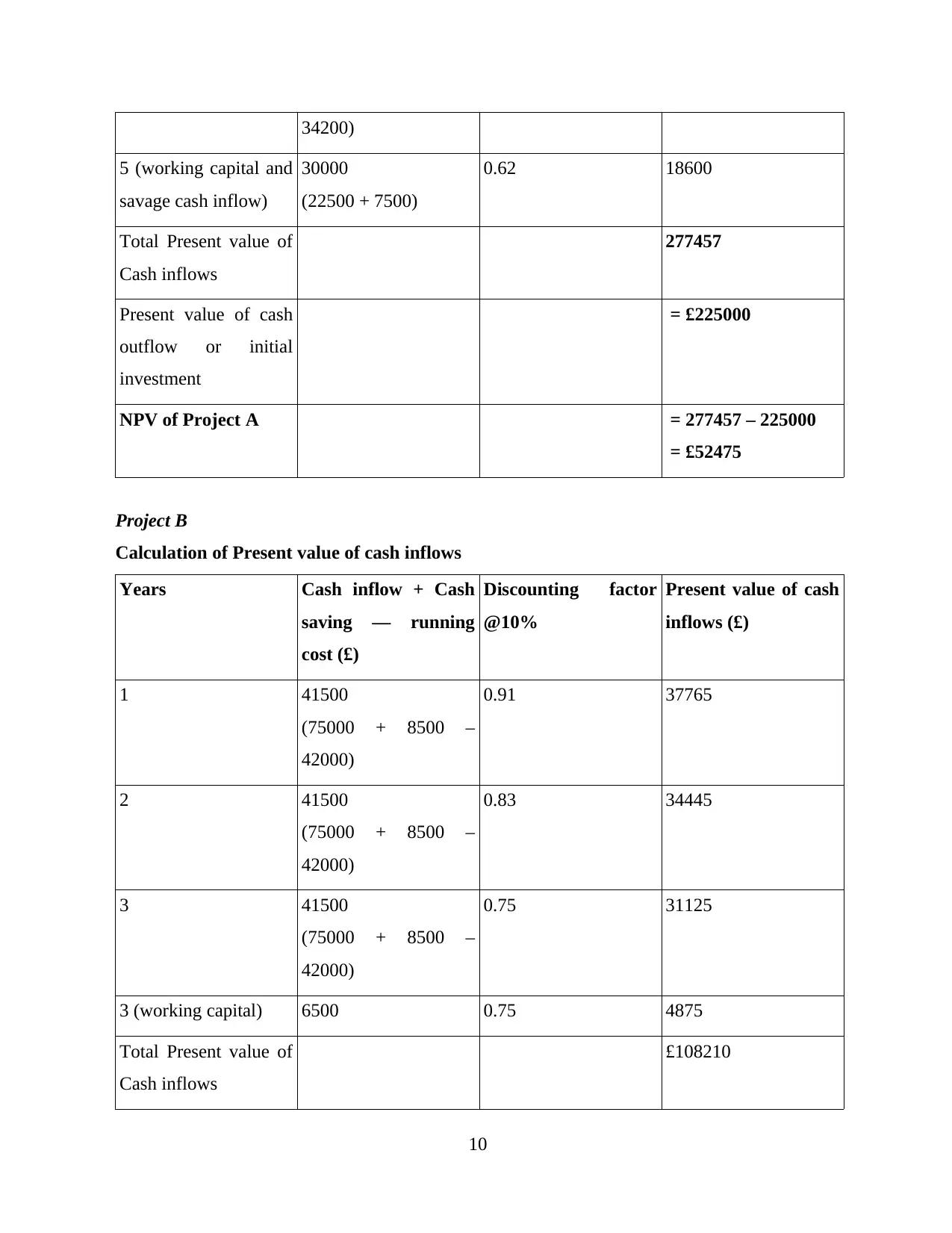
34200)
5 (working capital and
savage cash inflow)
30000
(22500 + 7500)
0.62 18600
Total Present value of
Cash inflows
277457
Present value of cash
outflow or initial
investment
= £225000
NPV of Project A = 277457 – 225000
= £52475
Project B
Calculation of Present value of cash inflows
Years Cash inflow + Cash
saving — running
cost (£)
Discounting factor
@10%
Present value of cash
inflows (£)
1 41500
(75000 + 8500 –
42000)
0.91 37765
2 41500
(75000 + 8500 –
42000)
0.83 34445
3 41500
(75000 + 8500 –
42000)
0.75 31125
3 (working capital) 6500 0.75 4875
Total Present value of
Cash inflows
£108210
10
5 (working capital and
savage cash inflow)
30000
(22500 + 7500)
0.62 18600
Total Present value of
Cash inflows
277457
Present value of cash
outflow or initial
investment
= £225000
NPV of Project A = 277457 – 225000
= £52475
Project B
Calculation of Present value of cash inflows
Years Cash inflow + Cash
saving — running
cost (£)
Discounting factor
@10%
Present value of cash
inflows (£)
1 41500
(75000 + 8500 –
42000)
0.91 37765
2 41500
(75000 + 8500 –
42000)
0.83 34445
3 41500
(75000 + 8500 –
42000)
0.75 31125
3 (working capital) 6500 0.75 4875
Total Present value of
Cash inflows
£108210
10
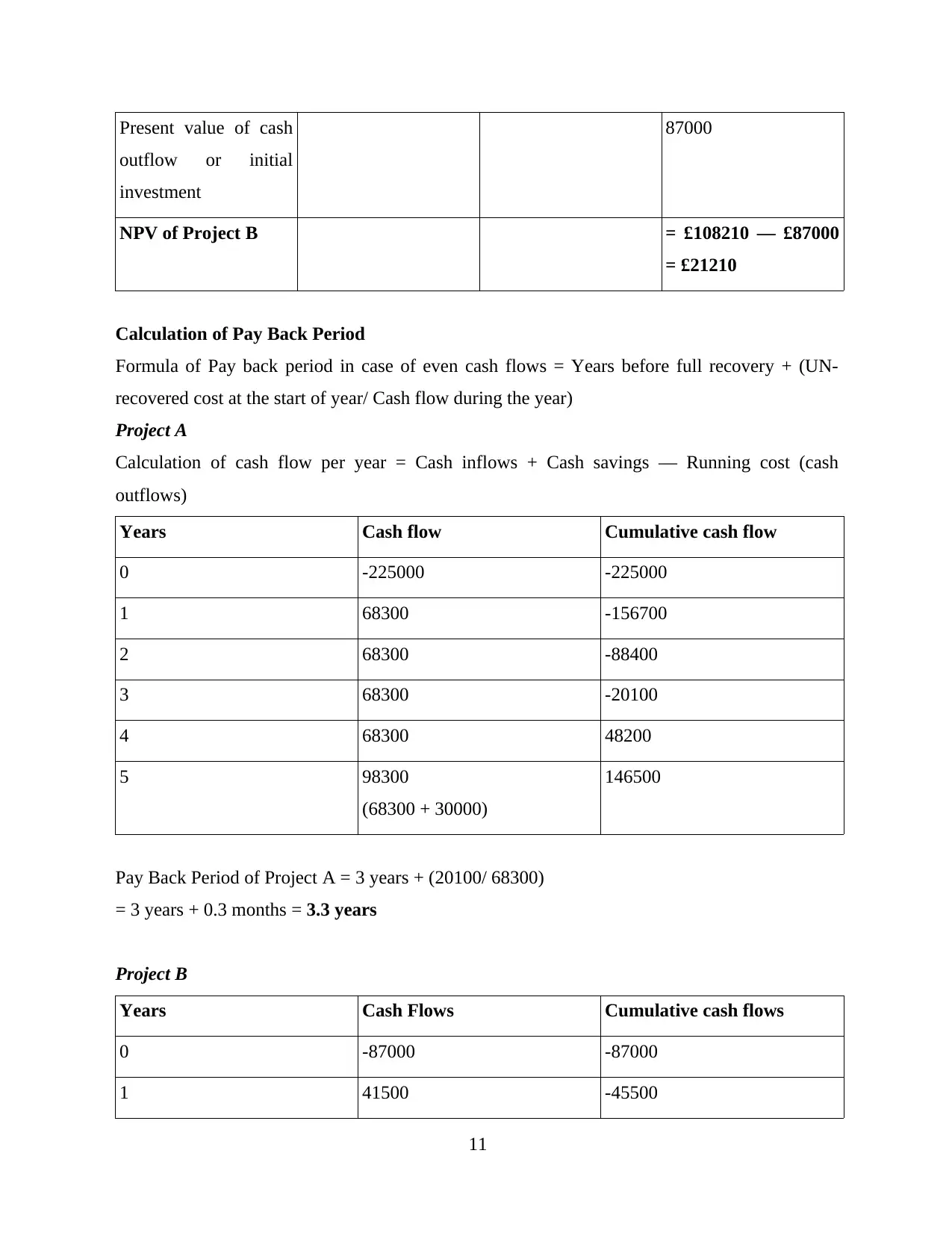
Present value of cash
outflow or initial
investment
87000
NPV of Project B = £108210 — £87000
= £21210
Calculation of Pay Back Period
Formula of Pay back period in case of even cash flows = Years before full recovery + (UN-
recovered cost at the start of year/ Cash flow during the year)
Project A
Calculation of cash flow per year = Cash inflows + Cash savings — Running cost (cash
outflows)
Years Cash flow Cumulative cash flow
0 -225000 -225000
1 68300 -156700
2 68300 -88400
3 68300 -20100
4 68300 48200
5 98300
(68300 + 30000)
146500
Pay Back Period of Project A = 3 years + (20100/ 68300)
= 3 years + 0.3 months = 3.3 years
Project B
Years Cash Flows Cumulative cash flows
0 -87000 -87000
1 41500 -45500
11
outflow or initial
investment
87000
NPV of Project B = £108210 — £87000
= £21210
Calculation of Pay Back Period
Formula of Pay back period in case of even cash flows = Years before full recovery + (UN-
recovered cost at the start of year/ Cash flow during the year)
Project A
Calculation of cash flow per year = Cash inflows + Cash savings — Running cost (cash
outflows)
Years Cash flow Cumulative cash flow
0 -225000 -225000
1 68300 -156700
2 68300 -88400
3 68300 -20100
4 68300 48200
5 98300
(68300 + 30000)
146500
Pay Back Period of Project A = 3 years + (20100/ 68300)
= 3 years + 0.3 months = 3.3 years
Project B
Years Cash Flows Cumulative cash flows
0 -87000 -87000
1 41500 -45500
11
Paraphrase This Document
Need a fresh take? Get an instant paraphrase of this document with our AI Paraphraser
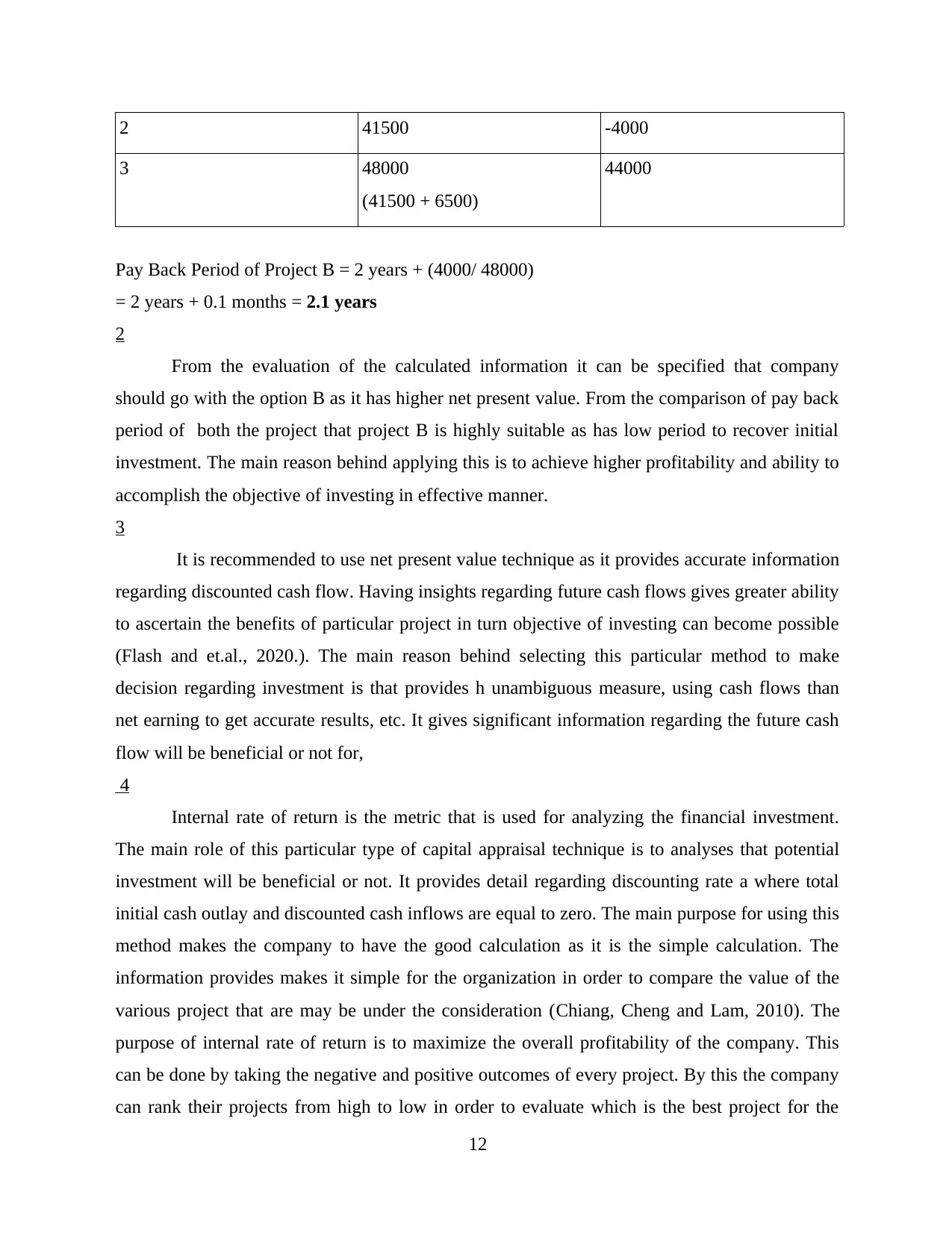
2 41500 -4000
3 48000
(41500 + 6500)
44000
Pay Back Period of Project B = 2 years + (4000/ 48000)
= 2 years + 0.1 months = 2.1 years
2
From the evaluation of the calculated information it can be specified that company
should go with the option B as it has higher net present value. From the comparison of pay back
period of both the project that project B is highly suitable as has low period to recover initial
investment. The main reason behind applying this is to achieve higher profitability and ability to
accomplish the objective of investing in effective manner.
3
It is recommended to use net present value technique as it provides accurate information
regarding discounted cash flow. Having insights regarding future cash flows gives greater ability
to ascertain the benefits of particular project in turn objective of investing can become possible
(Flash and et.al., 2020.). The main reason behind selecting this particular method to make
decision regarding investment is that provides h unambiguous measure, using cash flows than
net earning to get accurate results, etc. It gives significant information regarding the future cash
flow will be beneficial or not for,
4
Internal rate of return is the metric that is used for analyzing the financial investment.
The main role of this particular type of capital appraisal technique is to analyses that potential
investment will be beneficial or not. It provides detail regarding discounting rate a where total
initial cash outlay and discounted cash inflows are equal to zero. The main purpose for using this
method makes the company to have the good calculation as it is the simple calculation. The
information provides makes it simple for the organization in order to compare the value of the
various project that are may be under the consideration (Chiang, Cheng and Lam, 2010). The
purpose of internal rate of return is to maximize the overall profitability of the company. This
can be done by taking the negative and positive outcomes of every project. By this the company
can rank their projects from high to low in order to evaluate which is the best project for the
12
3 48000
(41500 + 6500)
44000
Pay Back Period of Project B = 2 years + (4000/ 48000)
= 2 years + 0.1 months = 2.1 years
2
From the evaluation of the calculated information it can be specified that company
should go with the option B as it has higher net present value. From the comparison of pay back
period of both the project that project B is highly suitable as has low period to recover initial
investment. The main reason behind applying this is to achieve higher profitability and ability to
accomplish the objective of investing in effective manner.
3
It is recommended to use net present value technique as it provides accurate information
regarding discounted cash flow. Having insights regarding future cash flows gives greater ability
to ascertain the benefits of particular project in turn objective of investing can become possible
(Flash and et.al., 2020.). The main reason behind selecting this particular method to make
decision regarding investment is that provides h unambiguous measure, using cash flows than
net earning to get accurate results, etc. It gives significant information regarding the future cash
flow will be beneficial or not for,
4
Internal rate of return is the metric that is used for analyzing the financial investment.
The main role of this particular type of capital appraisal technique is to analyses that potential
investment will be beneficial or not. It provides detail regarding discounting rate a where total
initial cash outlay and discounted cash inflows are equal to zero. The main purpose for using this
method makes the company to have the good calculation as it is the simple calculation. The
information provides makes it simple for the organization in order to compare the value of the
various project that are may be under the consideration (Chiang, Cheng and Lam, 2010). The
purpose of internal rate of return is to maximize the overall profitability of the company. This
can be done by taking the negative and positive outcomes of every project. By this the company
can rank their projects from high to low in order to evaluate which is the best project for the
12
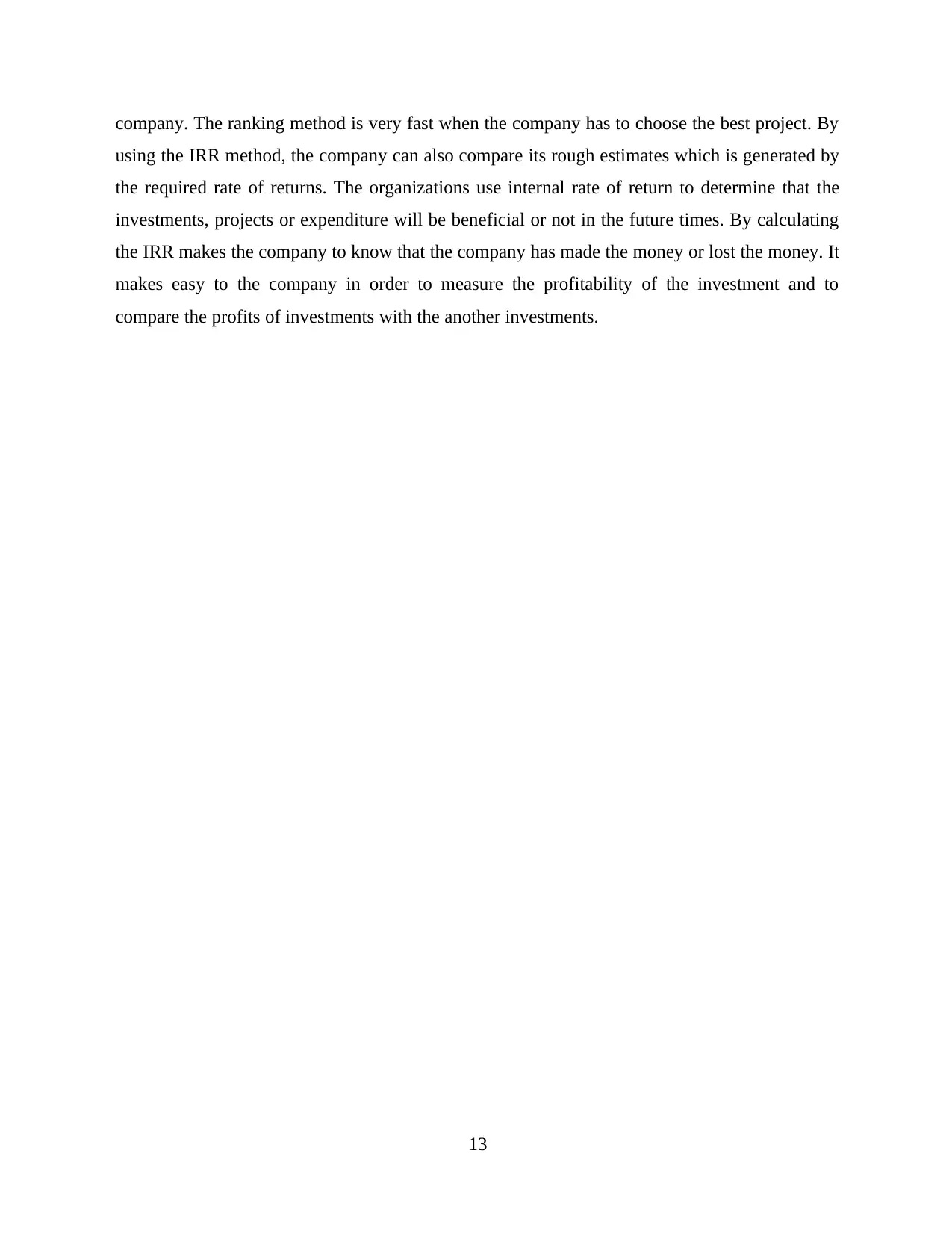
company. The ranking method is very fast when the company has to choose the best project. By
using the IRR method, the company can also compare its rough estimates which is generated by
the required rate of returns. The organizations use internal rate of return to determine that the
investments, projects or expenditure will be beneficial or not in the future times. By calculating
the IRR makes the company to know that the company has made the money or lost the money. It
makes easy to the company in order to measure the profitability of the investment and to
compare the profits of investments with the another investments.
13
using the IRR method, the company can also compare its rough estimates which is generated by
the required rate of returns. The organizations use internal rate of return to determine that the
investments, projects or expenditure will be beneficial or not in the future times. By calculating
the IRR makes the company to know that the company has made the money or lost the money. It
makes easy to the company in order to measure the profitability of the investment and to
compare the profits of investments with the another investments.
13
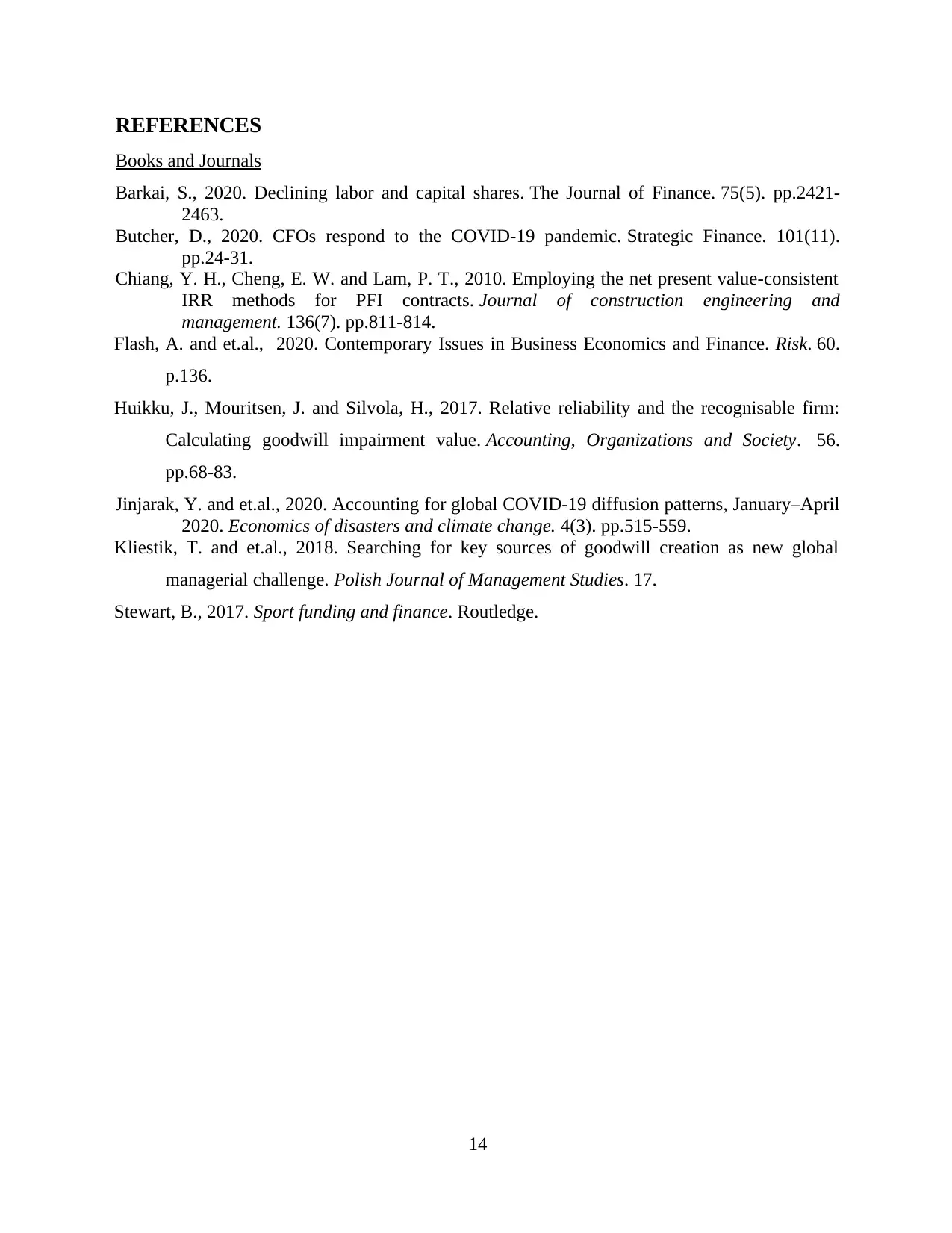
REFERENCES
Books and Journals
Barkai, S., 2020. Declining labor and capital shares. The Journal of Finance. 75(5). pp.2421-
2463.
Butcher, D., 2020. CFOs respond to the COVID-19 pandemic. Strategic Finance. 101(11).
pp.24-31.
Chiang, Y. H., Cheng, E. W. and Lam, P. T., 2010. Employing the net present value-consistent
IRR methods for PFI contracts. Journal of construction engineering and
management. 136(7). pp.811-814.
Flash, A. and et.al., 2020. Contemporary Issues in Business Economics and Finance. Risk. 60.
p.136.
Huikku, J., Mouritsen, J. and Silvola, H., 2017. Relative reliability and the recognisable firm:
Calculating goodwill impairment value. Accounting, Organizations and Society. 56.
pp.68-83.
Jinjarak, Y. and et.al., 2020. Accounting for global COVID-19 diffusion patterns, January–April
2020. Economics of disasters and climate change. 4(3). pp.515-559.
Kliestik, T. and et.al., 2018. Searching for key sources of goodwill creation as new global
managerial challenge. Polish Journal of Management Studies. 17.
Stewart, B., 2017. Sport funding and finance. Routledge.
14
Books and Journals
Barkai, S., 2020. Declining labor and capital shares. The Journal of Finance. 75(5). pp.2421-
2463.
Butcher, D., 2020. CFOs respond to the COVID-19 pandemic. Strategic Finance. 101(11).
pp.24-31.
Chiang, Y. H., Cheng, E. W. and Lam, P. T., 2010. Employing the net present value-consistent
IRR methods for PFI contracts. Journal of construction engineering and
management. 136(7). pp.811-814.
Flash, A. and et.al., 2020. Contemporary Issues in Business Economics and Finance. Risk. 60.
p.136.
Huikku, J., Mouritsen, J. and Silvola, H., 2017. Relative reliability and the recognisable firm:
Calculating goodwill impairment value. Accounting, Organizations and Society. 56.
pp.68-83.
Jinjarak, Y. and et.al., 2020. Accounting for global COVID-19 diffusion patterns, January–April
2020. Economics of disasters and climate change. 4(3). pp.515-559.
Kliestik, T. and et.al., 2018. Searching for key sources of goodwill creation as new global
managerial challenge. Polish Journal of Management Studies. 17.
Stewart, B., 2017. Sport funding and finance. Routledge.
14
1 out of 16
Related Documents
Your All-in-One AI-Powered Toolkit for Academic Success.
+13062052269
info@desklib.com
Available 24*7 on WhatsApp / Email
![[object Object]](/_next/static/media/star-bottom.7253800d.svg)
Unlock your academic potential
© 2024 | Zucol Services PVT LTD | All rights reserved.



